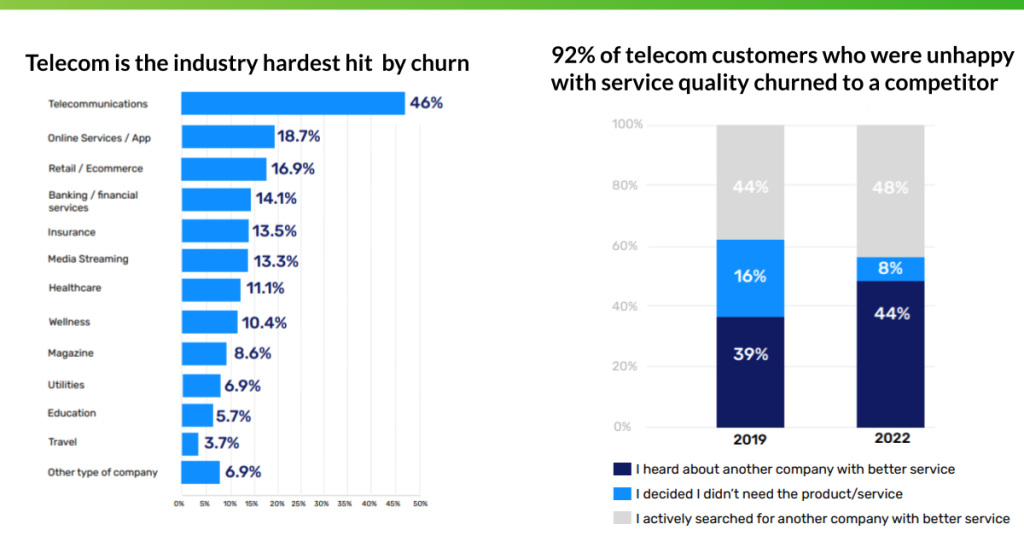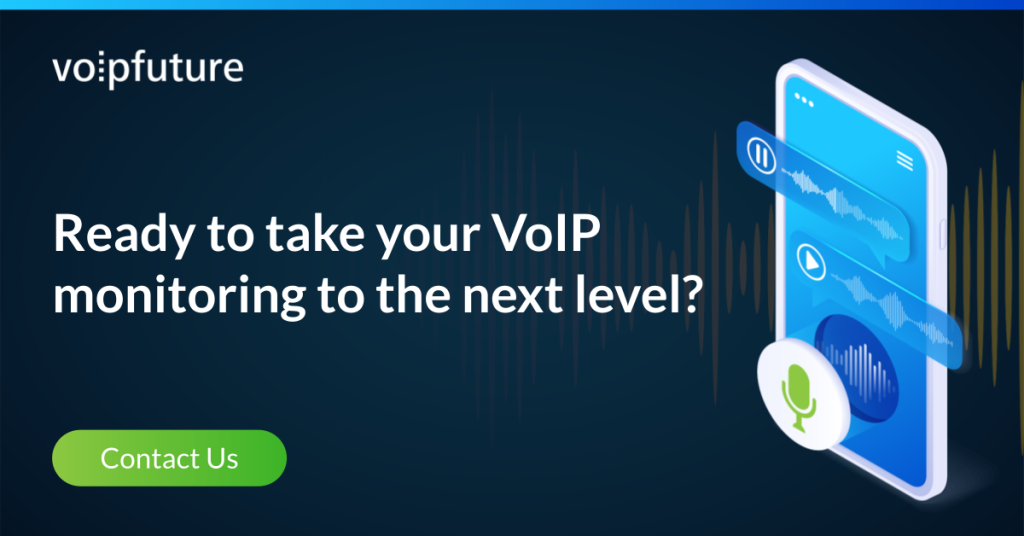It has never been more important to deliver great service than it is these days. Customers now expect technology to work without a hitch, all the time. It only takes one or two bad experiences, and before you know it, they’ve moved on to a competitor. This is especially true in the telecom industry, which according to a U.S. survey has the highest churn rate of any industry.
Almost half of U.S. consumers (46%) say they have canceled a product (e.g., phone, internet, TV, etc.) because of poor quality of service. Comparing data from 2019 and 2022 shows cancellations due to no longer needing the service are dropping. Instead, 92% of the time, customers find an alternative with improved service quality through word of mouth, marketing, or actively searching for themselves.

Based on another report, conducted by CustomerGauge, the number one reason for why customer churn in telecoms is so high is poor network quality. It is vital that customers find a service provider that provides efficient, reliable, and wide-ranging network coverage. Network quality problems account for about 45% of smartphone churn.
Even a slight upswing in customer retention can dramatically affect profit margins. With so much at stake, communication service providers (CSPs) need to have complete control over every aspect of call quality in order to deliver the best possible user experience.
While CSPs strive to deliver excellent service quality, in an industry this complex, issues will always arise. In these instances, maintaining a successful customer experience relies upon quickly solving the problem (i.e., the first time they call) and standard service resuming. This is impossible without voice monitoring tools and analytics that are capable of delivering real-time data.
The time it takes to trace the user’s call history, gather all the relevant network data, and determine the root cause of the problem is time the customer can spend searching for a new provider.
With so much weight placed on voice service quality, CSPs must find the right tools and solutions to monitor their network and proactively solve any issues before they affect the customer experience. With multiple monitoring solutions available, how do CSPs know which tools to use? Below are six questions you should ask when investigating new network monitoring and voice analytics tools.
1. Does the solution offer visibility for both SIP and RTP data?
Call quality metrics can be divided into those that track the control plane and those that measure the media flying back and forth. However, the history of telephony means there is often an overemphasis on the control plane and connectivity at the expense of media quality.
Traditional telephony is rooted in circuit switching and establishing a physical connection between the parties communicating. Once there is a piece of copper connecting the caller and receiver, there is little that can go wrong during data transfer. Therefore, there is a much more substantial body of work developing tools and methods to establish control plane metrics and understand the quality of the connection.
But the internet protocol (IP) changed everything, with data now broken up into packets and sent across complex networks. A lot can go wrong with these packets, and it is critical to understand the network’s performance when transferring media.
Modern voice monitoring solutions must provide dual visibility, putting both Session Initiation Protocol (SIP) signaling data and Real-time Transport Protocol (RTP) media streams in full view.

SIP establishes and maintains the connection across the internet, and RTP is the protocol transporting the actual media. Therefore, it is RTP that defines what users actually hear.
An example where tracking media quality is vital is a silent call. The connection is established and maintained from a control plane point of view, but the call parties can’t communicate. Without effectively monitoring the RTP streams, it would be difficult to spot the issue in the data.
2. Does the solution offer truly actionable insights?
Monitoring calls and voice analytics is only valuable when it provides actionable insights that improve the customer experience—particularly by detecting patterns in the SIP and RTP data— to provide root cause analysis and clear customer support tickets faster.
With most voice monitoring tools, analyzing data and finding the root cause of a problem is time-consuming. They struggle with incomplete data or require staff with expert knowledge to troubleshoot the problem. This complicates operations and delays the mean time to repair (MTTR).
Everyone is talking about machine learning, but most tools fail to detect simple known patterns in SIP and RTP traffic—the ones that severely degrade user experience. Many solutions provide only traces of the customer’s call history, giving no hint as to the root cause of the problem. Without the necessary information to solve the problem, customer support staff are reduced to recording the complaint, passing information along to engineering staff, waiting for the response, and asking the customer to report any further issues—an extremely inefficient process.
A better approach introduces advanced voice monitoring technology that tracks SIP and RTP traffic at multiple points in the network to isolate any issues. By comparing performance at different points in the network, modern solutions can provide automatic root cause indicators powered by AI and machine learning.
With solutions tracking SIP and RTP data to spot known impairment patterns, CSPs can proactively tackle network issues and dramatically speed up the troubleshooting process when complaints are made. Automatic root cause indicators provide the actionable insights needed to deliver voice services that people will keep returning to.
3. How does the solution correlate all measurements of a call?
As we mentioned in question one, dual visibility for both SIP signaling and RTP media is critical for successful voice analytics. However, the real benefits occur when the solution is capable of matching, or correlating, data from both streams to understand the connection between the control and media planes.

Many solutions only offer SIP-based correlation, which casts aside essential media plane data. The gold standard is SIP/RTP correlation based on multiple levels.
Firstly, linking signaling and media information while calls are in progress to correlate various data records (xDRs) and streams for troubleshooting and voice analytics. Secondly, connecting xDRs and streams to create call data records (CDRs) that represent an end-to-end view of the call, containing everything the CSP needs to know, such as:
- The call start time, end time, connect time, and duration
- Party numbers for the caller and receiver
- Hang-up cause
- Codecs for both call directions
- MOS, packet loss, jitter, and other media quality metrics for both call directions
- And much more
4. How can you slice and dice the data?
Gathering the right data is a great start, but how does the solution arrange, store, and report its findings? Decision support tools require flexible reporting to allow for voice analytics to test multiple hypotheses, look at the data from different angles, enable understanding of trends, and decide on the best course of action for better customer experience.
If the system only supports grouping by so-called realms, which does not allow to create arbitrary service statistics, then you have to rethink. You really want to make sure the system allows to group and aggregate data along a number of relevant dimensions. For flexibility in reporting on individual sites, services, and routes monitoring solutions should establish stats using IP-based trunk definitions, numbering plans, and probes.
Reporting options improve the voice monitoring solution’s ability to reflect network performance and the resulting service quality. Available options should include:
- Features that let users create custom reports, slicing and dicing the data however they want
- Exporting data and query results in multiple formats such as PDF, HTML, and CSV files
- Interfacing with third-party tools, whether they be statistics databases or CSV feeds
5. Can the solution perform on-demand packet recording?
CSPs should be able to record packets on demand, depending on what they want to investigate. This could be packet recording triggered by a performance drop or restricted to a specific probe. These capture triggers should be defined by specific thresholds for transport quality or user experience.
Recording the raw packet data is mainly needed to produce call flow diagrams and to present concrete first-hand evidence of faulty equipment to vendors. While less common, sometimes you also want to manually analyze capture files during troubleshooting.
Packet recording can and should also be used to capture SIP and RTP packets related to VoIP calls. This feature is mainly used for troubleshooting purposes and for documenting non-standard behavior of network elements to their vendors.
More advanced solutions also offer selective recording by setting up filters to record calls based on IP address, subscriber information or other characteristics. This type of recordings include all media packets in their original state conserving their transport and timing characteristics as well as the SIP signaling session.
Quality-based recording is another advanced capability offered by some solutions. RTP streams are selected for capturing, when their quality falls below a defined threshold. This reduces the amount of captured data to traces of interest.
Needless to say that selective/quality-based recording (as opposed to just recording everything) is paramount. You just don’t want to sift through gigabytes of trace files to find that one event of interest.
Finally, RTP packet recording should be possible without capturing the payload to protect customer privacy.
6. What service quality metrics and KPIs does the solution provide?
Signaling quality essentially determines whether it is possible to set up a call at all. However, once a call is established, audio quality defines the user experience, i.e., the quality of the RTP flows. Problems with the transport performance of a network do not always affect the user experience. The impact of jitter or packet loss on user experience depends on the severity and distribution of impairments over time and on the used codec.
Best-in-class voice monitoring solutions provide a range of service quality metrics for both signaling and media data. As we mentioned before, there can be an overemphasis on signaling, and most tools provide relevant metrics for the control plane. However, there is considerable variation in the availability and standard of media KPIs delivered by voice monitoring solutions.
The Internet Engineering Task Force (IETF) defines a rich set of service quality metrics and KPIs for SIP in the RFC 6076 document. This includes many metrics which enable the rapid assessment of signaling technical issues beyond the commonly available final responses and hang-up causes.
While signaling quality is important in determining whether the call could be established, the media quality determines the standard of audio delivered. Therefore, CSPs require real-time call quality metrics, such as Mean Opinion Score (MOS), across the duration of the call.
One score for an entire call does not accurately reflect customer experience (a high-quality call could suddenly drop, causing a quick hang-up without significantly impacting the average). Instead, solutions should segment the stream into fixed time slices that show the varying voice quality of the service throughout the call.
With time-sliced data, call quality issues can be pinpointed to a specific moment in time and correlated with signaling data and other network information. Additionally, with a fixed segment length, CSPs can simplify their statistics when it comes to comparing and aggregating service quality data.
A metric with growing interest is MOS minutes, the quality rating for each call minute. With MOS minutes, it is possible to concisely reflect overall voice service quality.

Summary
Beyond the technical aspects of voice monitoring services covered above, you also need to ensure it fits with your existing operations. This includes:
- Scalability
- Payment model
- Support for different deployments (i.e., cloud, hybrid)
- Integration with third-party systems
Voice monitoring solutions and analytics are the key to delivering outstanding user experiences and reducing customer churn. While there is considerable variation in the quality of solutions available, asking these six questions can help you get the tools you need to enhance services.
Contact us to learn more about Qrystal and how it stacks up against all the above mentioned questions.


